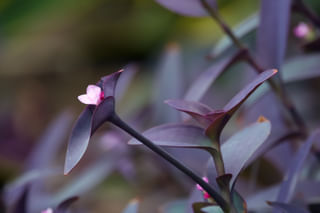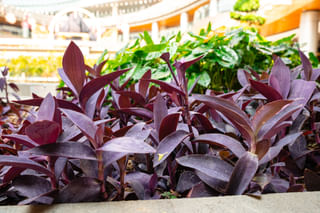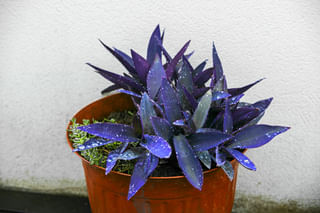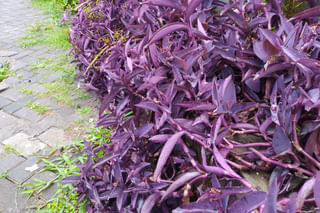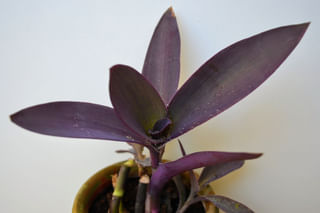A Beginner's Guide to Caring for a Purple Heart Plant (Tradescantia pallida)
Learn how to care for your Tradescantia pallida with this comprehensive guide. Learn essential tips on watering, feeding, pruning, propagation, and tackling common issues like pests and diseases to keep your Purple Heart plant healthy and thriving.
If you're looking for a unique and exciting houseplant, you've come to the right place! If you're looking for a houseplant that isn't green, the Tradescantia pallida might be a great choice as your next plant!
It's beautiful and easy to look after, which is great whether you're just starting or you've been gardening for ages. Let me give you a quick rundown on how to keep your Purple Heart looking good and growing strong.
These are the topics we're going to look at in this guide:
Let's start and look at how we can care for this purple beauty!
Ideal growing conditions
To ensure your Purple Heart plant thrives, it's important to give it a growing environment in which it'll feel happy and at home. Here's how you can do that:
Lighting
The Tradescantia pallida plant loves bright light, but not directly on its leaves. Think of putting it near a window where it can soak up some light without getting a sunburn. You gotta find that sweet spot because too much direct sun can make its gorgeous purple leaves go dull. A window facing north or east is usually just right – it gets enough light without the harsh afternoon sun.
Temperature
Keeping your Tradescantia pallida plant happy is all about the warmth! It loves slightly higher temperatures around 70℉ (21℃). Make sure to keep it away from those chilly drafts or spots that could drop below 50℉ (10℃): think air conditioning in the summer or cold windows in the winter. A nice, warm spot keeps it growing healthy and keeps those leaves looking vibrant.
Soil
Getting the soil mix just right can help your Tradescantia pallida thrive. You want to avoid soggy soil because it can cause root rot and other problems. Mixing potting soil with peat moss and a bit of perlite or vermiculite is the way to go. This combo gives your plant's roots the perfect home: keeping them healthy, airy, and ready to soak up all the good stuff like water and nutrients.
By combining lots of light, comfortable temperatures, and keeping the soil lightly moist at all times, you're creating the perfect growing environment for this houseplant.
Watering and feeding
We've already discovered how you can create the ideal growing environment for your Tradescantia pallida, so you're already halfway there! Now, let's find out how you can best water and feed your plant to keep it healthy long-term.
Watering
It's important to water your Purple Heart only when the top inch of the soil has dried out completely. This plant is particularly sensitive to overwatering as we've discovered in the section about the ideal soil. Overwatering can easily cause the roots to rot. To prevent this, ensure that your pot has drainage holes to allow excess water to escape. This not only helps in preventing root rot but also promotes a healthier root system.
If the plant starts to wilt or become limp, it might suffer from root rot and if the leaves start to get brown crispy tips, it's likely too dry.
Feeding
To keep your Purple Heart growing strong, it's a good idea to feed it with a balanced, water-soluble fertilizer once a month during its growing season, from spring to summer. This will give it all the nutrients it needs to flourish and show off that vibrant foliage. But when the cooler months of fall and winter roll around and it starts to grow a bit slower, you should stop to feed this plant. This way, you avoid overloading it with nutrients, which could do more harm than good.
Once spring is starting again, you can start to feed your fast-growing Tradescantia pallida again.
So if you're looking at watering and feeding your Tradescantia pallida, you can see that it's quite an easy plant to take care of. It needs regular feeding and will tell you when it's not happy with its watering schedule. That makes this plant great for beginning plant owners.
Pruning and propagation
When you're taking care of your Tradescantia pallida during the spring and summer, you'll notice that it starts to grow quickly. It's a plant that likes to spread out quite quickly, so you'll probably find yourself needing to prune this plant regularly.
Luckily, pruning and propagation are straightforward tasks when it comes to caring for Tradescantia pallida. Let's see how we can do this:
Pruning
If you want your Tradescantia pallida to look lush and bushy, you can try to pinch back their stems. It's super easy! Just use your fingers to gently snip off the tips of the stem. This stops growth from the end of the stem but encourages new branches to grow. These new stems will grow new leaves and will give your plant a bushier appearance.
You can also cut off long stems and propagate them. Let's look at how to do this.
Propagation
When you prune longer stems on your Tradescantia pallida, you can often propagate them to create new plants that you can share with friends and family. Propagating Tradescantia pallida is super easy! Here's how you can do this:
- Grab a healthy stem, about 4-6 inches long, and strip the bottom inch of leaves to keep it from rotting in water.
- Place the stem into a container of water, making sure the part without leaves is underwater.
- Find a spot with some indirect light and just wait a couple of weeks for roots to show up.
- Once those roots hit about an inch, you're ready to move it to the soil.
If you're growing your cutting in a glass jar, you might notice algae growing after a little while. When you start to see this, make sure to clean the jar and refresh the water. Also, the part of the cutting that's underwater starts to rot, make sure to trim this part off and try again.
Common issues and solutions
Now that we've looked at the most important parts of taking care of Tradescantia pallida, let's have a look at some of the problems you might encounter when taking care of your purple plant.
Watch out for these common problems:
Pests
Got pests like spider mites and aphids on your Tradescantia pallida? These tiny pests can do some serious damage if you don't catch them early. Sometimes, it's tough to spot them, but if your leaves are looking a little sad, that's a big hint they're around. Most pests are attracted to weak plants, so if you've overwatered your plant a few times, you should pay extra attention to small spiderwebs or tiny flies around your plant.
Did you spot pests on your plant? A quick fix is giving your plants a gentle bath with some soapy water. This soap suffocates the pests on your plant. For the best result, make sure to repeat this process once per week for 3-4 weeks.
If the pests don't go away using this method, you might want to look at The 7 most common houseplant pests and how to control them to find alternative methods to get rid of pests.
Diseases
Another big issue for plants is getting fungal diseases, usually because of too much water. When plants start looking soggy or turn a strange color, it's a big sign that something is wrong. The best move? Check how often you're watering them. Make sure the soil drains well and isn't staying too wet for too long.
If the fungus doesn't go away when you let the plant dry out for a while, you might need to look into fungicide sprays to help get rid of the problems. But, usually, letting the plant and the soil dry out does a great job of making it difficult for the fungus to survive on or around your plant.
Thank you for reading this post! I hope it helps you to keep your plants healthy and beautiful! If you're looking for more guides on specific plants, you can always request a plant guide to get a guide for the plant you have trouble with.
Test your plant care knowledge
Quiz completed!
Want to learn more? Sign up for my newsletter to receive free tips in your inbox!
Sign up now!